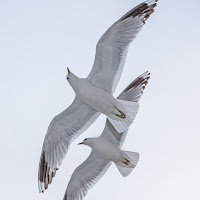MEW GULL
MEW GULL (Larus canus) – (See images below)
DESCRIPTION: The Mew Gull breeding adult has a white head and neck, and white breast and under parts. Bill, legs and feet are yellow, eyes and talons are black. There is a reddish eye ring. Back is grey. Wings are grey with black tips that have some white spots. Rump and tail are white. Nonbreeding adult has grey streaks on the head. Bill may have a dark tip. Bill and legs are dull yellow. Juveniles are mottled grey-brown. Tail is white with black bar. Bill is dark grey. Sexes are similar. Bird length is around 45 cm (18 inches) long. There are four subspecies.
VOICE: https://www.xeno-canto.org/species/Larus-canus
NAME: ‘Gull’ would have its origins in Old Celtic ‘Gullan’ and other languages, including Latin ‘gula’ for throat. As per Choate this would be related to the gull’s ‘indiscriminate’ scavenging habits, its ‘willingness to swallow almost anything’ (think ‘gullible’). Latin genus name ‘Larus’ refers to a gull. Latin species name ‘canus’ means ‘grey’. This bird is called ‘Common Gull’ outside North America.
HABITAT: Lakes in the summer, coastal waters in winter.
DIET: Omnivorous – insects, crustaceans, small fish, molluscs, small mammals and birds, some seeds and grain, garbage, carrion.
NESTING: Breeds in colonies on high ground near water, or on gravel roofs (Europe). Nest is lined with various materials. Usually threegreen-beige eggs are laid, incubated by both parents. Chicks fed by both parents.
DISTRIBUTION: Breeding range covers northwest Canada, Alaska, and northern Europe and Asia. Winters along west coast of North America, eastern Asia including Japan, and coastal Europe and Mediterranean Sea. Some individuals have also reached Hawaii as vagrants (see note below).
Distribution Map: https://en.wikipedia.org/wiki/Common_gull#/media/File:Larus_canus_map.svg
ON PEI: Does not breed on Prince Edward Island, sightings occasional in winter.
CONSERVATION: Common and widespread, not currently considered at risk.
Vagrancy: In biology this means an animal going way outside its normal range. For birds, this can happen when there are storms and they get blown off course. On other times, the bird simply wanders in a different direction than usual. Here’s an article about vagrancy in birds.
GULLS ON HAWAII: Gulls are not long time residents or indigenous to Hawaii. They are continental species and the Hawaiian Islands don’t seem to provide them with the habitat they need. Those birds that do make it however have either flown on their own or got blown off course, or hitched a ride on ships. In either case they don’t stay for long.
SIMILAR SPECIES: Ring-billed Gull, Herring Gull
REFERENCES: http://fieldguide.mt.gov/speciesDetail.aspx?elcode=ABNNM03090 (Montana Field Guide)
https://animaldiversity.org/accounts/Larus_canus/ (University of Michigan)
https://en.wikipedia.org/wiki/Common_gull
https://www.allaboutbirds.org/guide/Mew_Gull
https://birdatlas.mb.ca/accounts/speciesaccount.jsp?sp=MEGU&lang=en (Manitoba Breeding Bird Atlas)
https://www.audubon.org/field-guide/bird/mew-gull
https://identify.whatbird.com/obj/130/overview/Mew_Gull.aspx
http://www.oiseaux-birds.com/card-mew-gull.html
https://www.borealbirds.org/bird/mew-gull
DESCRIPTION: The Mew Gull breeding adult has a white head and neck, and white breast and under parts. Bill, legs and feet are yellow, eyes and talons are black. There is a reddish eye ring. Back is grey. Wings are grey with black tips that have some white spots. Rump and tail are white. Nonbreeding adult has grey streaks on the head. Bill may have a dark tip. Bill and legs are dull yellow. Juveniles are mottled grey-brown. Tail is white with black bar. Bill is dark grey. Sexes are similar. Bird length is around 45 cm (18 inches) long. There are four subspecies.
VOICE: https://www.xeno-canto.org/species/Larus-canus
NAME: ‘Gull’ would have its origins in Old Celtic ‘Gullan’ and other languages, including Latin ‘gula’ for throat. As per Choate this would be related to the gull’s ‘indiscriminate’ scavenging habits, its ‘willingness to swallow almost anything’ (think ‘gullible’). Latin genus name ‘Larus’ refers to a gull. Latin species name ‘canus’ means ‘grey’. This bird is called ‘Common Gull’ outside North America.
HABITAT: Lakes in the summer, coastal waters in winter.
DIET: Omnivorous – insects, crustaceans, small fish, molluscs, small mammals and birds, some seeds and grain, garbage, carrion.
NESTING: Breeds in colonies on high ground near water, or on gravel roofs (Europe). Nest is lined with various materials. Usually threegreen-beige eggs are laid, incubated by both parents. Chicks fed by both parents.
DISTRIBUTION: Breeding range covers northwest Canada, Alaska, and northern Europe and Asia. Winters along west coast of North America, eastern Asia including Japan, and coastal Europe and Mediterranean Sea. Some individuals have also reached Hawaii as vagrants (see note below).
Distribution Map: https://en.wikipedia.org/wiki/Common_gull#/media/File:Larus_canus_map.svg
ON PEI: Does not breed on Prince Edward Island, sightings occasional in winter.
CONSERVATION: Common and widespread, not currently considered at risk.
Vagrancy: In biology this means an animal going way outside its normal range. For birds, this can happen when there are storms and they get blown off course. On other times, the bird simply wanders in a different direction than usual. Here’s an article about vagrancy in birds.
GULLS ON HAWAII: Gulls are not long time residents or indigenous to Hawaii. They are continental species and the Hawaiian Islands don’t seem to provide them with the habitat they need. Those birds that do make it however have either flown on their own or got blown off course, or hitched a ride on ships. In either case they don’t stay for long.
SIMILAR SPECIES: Ring-billed Gull, Herring Gull
REFERENCES: http://fieldguide.mt.gov/speciesDetail.aspx?elcode=ABNNM03090 (Montana Field Guide)
https://animaldiversity.org/accounts/Larus_canus/ (University of Michigan)
https://en.wikipedia.org/wiki/Common_gull
https://www.allaboutbirds.org/guide/Mew_Gull
https://birdatlas.mb.ca/accounts/speciesaccount.jsp?sp=MEGU&lang=en (Manitoba Breeding Bird Atlas)
https://www.audubon.org/field-guide/bird/mew-gull
https://identify.whatbird.com/obj/130/overview/Mew_Gull.aspx
http://www.oiseaux-birds.com/card-mew-gull.html
https://www.borealbirds.org/bird/mew-gull
 |
| Mew gull, breeding plumage AK, Donna A. Dewhurst, USFWS |
 |
| Mew gull, winter plumage, NotFromUtrecht |
 |
| Mew gulls in flight, by Bengt Nyman |